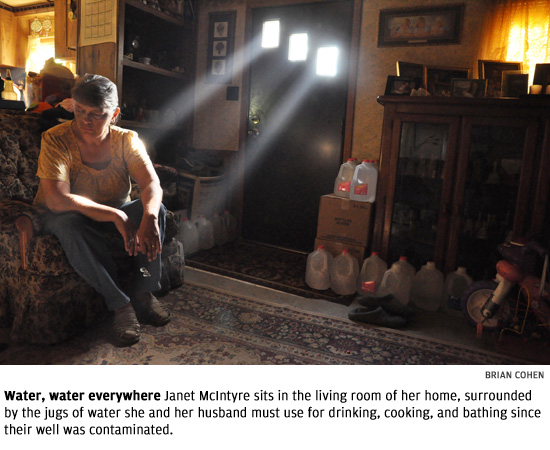
The story of Janet McIntyre, the woman in the photo above, embodies many of the reasons why Brian Cohen and his colleagues at the Marcellus Shale Documentary Project decided to keep working, even though the project officially ended in October, following an exhibit of their photographs, a panel discussion, and the publication of a book of photos and essays.
McIntyre and her husband live in a trailer on a small piece of land in western Pennsylvania, north of Pittsburgh. Two years ago, soon after energy companies began shooting a stew of chemicals into the ground nearby to free the deposits of natural gas locked in layers of rock, the McIntyres and their neighbors started complaining that the water in their wells had gone bad, giving them rashes and making them sick.
When Cohen, a photographer who hails from London, moved to Pittsburgh six years ago, he knew little about hydrofracking. In western Pennsylvania, though, the issue is impossible to ignore. The rush on Marcellus Shale—the gas field that runs beneath upstate New York, western Pennsylvania, eastern Ohio, and nearly all of West Virginia—has been in the headlines for years. In 2011, when a local foundation asked for proposals addressing the controversy, Cohen’s wife urged him to pitch something.
What Cohen envisioned was too much for one photographer, so he assembled a talented group of shooters that included Martha Rial, Scott Goldsmith, Lynn Johnson, Noah Addis, and Nina Berman. Over the next 13 months, they tried to document the environmental, social, and economic effects of fracking—positive and negative—on people in Pennsylvania: water that ignites, the glow of a drilling rig amid rolling farmland, portraits of folks who made enough money leasing their land to the energy companies to keep their farms going. This was not a crusade, but an attempt to contribute to an informed discussion about a complex and important story.
As the project wound down, the photographers got together and asked: What’s missing? A lot, of course, but Cohen says they were particularly interested in how the drilling has affected the social dynamics in these communities. “For me, the most important thing is the human story,” he says. “The relationship of the people to the process.”
Not surprisingly, this is among the most difficult aspects of the story to capture in a photograph—Janet McIntyre’s reluctance to let her grandkids come visit, for fear that they will get sick; the growing number of physicians who are getting involved in the debate; the effects of the truck traffic and the noise and the dust.
“I’ve learned so much doing this work,” Cohen says, “but I also know what I don’t know.” He is raising more money for the next phase, so he can pay the photographers, even if only a token amount. In the meantime, some of them, including Cohen, continue to work. “This is not like any project I’ve been involved in,” he says.
Brent Cunningham is CJR’s managing editor.
